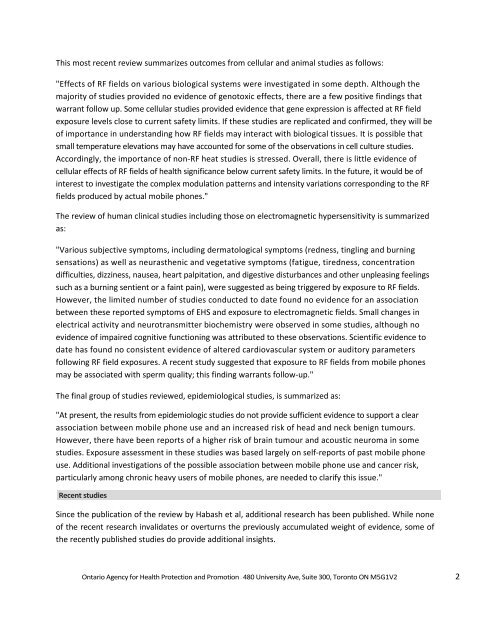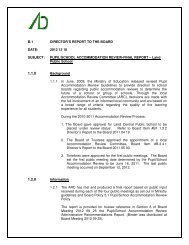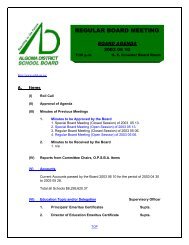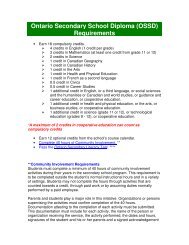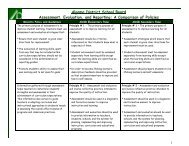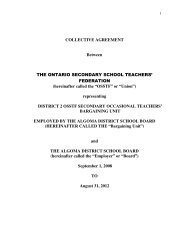Wireless Technology Use in Schools - Algoma District School Board
Wireless Technology Use in Schools - Algoma District School Board
Wireless Technology Use in Schools - Algoma District School Board
You also want an ePaper? Increase the reach of your titles
YUMPU automatically turns print PDFs into web optimized ePapers that Google loves.
This most recent review summarizes outcomes from cellular and animal studies as follows:"Effects of RF fields on various biological systems were <strong>in</strong>vestigated <strong>in</strong> some depth. Although themajority of studies provided no evidence of genotoxic effects, there are a few positive f<strong>in</strong>d<strong>in</strong>gs thatwarrant follow up. Some cellular studies provided evidence that gene expression is affected at RF fieldexposure levels close to current safety limits. If these studies are replicated and confirmed, they will beof importance <strong>in</strong> understand<strong>in</strong>g how RF fields may <strong>in</strong>teract with biological tissues. It is possible thatsmall temperature elevations may have accounted for some of the observations <strong>in</strong> cell culture studies.Accord<strong>in</strong>gly, the importance of non-RF heat studies is stressed. Overall, there is little evidence ofcellular effects of RF fields of health significance below current safety limits. In the future, it would be of<strong>in</strong>terest to <strong>in</strong>vestigate the complex modulation patterns and <strong>in</strong>tensity variations correspond<strong>in</strong>g to the RFfields produced by actual mobile phones."The review of human cl<strong>in</strong>ical studies <strong>in</strong>clud<strong>in</strong>g those on electromagnetic hypersensitivity is summarizedas:"Various subjective symptoms, <strong>in</strong>clud<strong>in</strong>g dermatological symptoms (redness, t<strong>in</strong>gl<strong>in</strong>g and burn<strong>in</strong>gsensations) as well as neurasthenic and vegetative symptoms (fatigue, tiredness, concentrationdifficulties, dizz<strong>in</strong>ess, nausea, heart palpitation, and digestive disturbances and other unpleas<strong>in</strong>g feel<strong>in</strong>gssuch as a burn<strong>in</strong>g sentient or a fa<strong>in</strong>t pa<strong>in</strong>), were suggested as be<strong>in</strong>g triggered by exposure to RF fields.However, the limited number of studies conducted to date found no evidence for an associationbetween these reported symptoms of EHS and exposure to electromagnetic fields. Small changes <strong>in</strong>electrical activity and neurotransmitter biochemistry were observed <strong>in</strong> some studies, although noevidence of impaired cognitive function<strong>in</strong>g was attributed to these observations. Scientific evidence todate has found no consistent evidence of altered cardiovascular system or auditory parametersfollow<strong>in</strong>g RF field exposures. A recent study suggested that exposure to RF fields from mobile phonesmay be associated with sperm quality; this f<strong>in</strong>d<strong>in</strong>g warrants follow-up."The f<strong>in</strong>al group of studies reviewed, epidemiological studies, is summarized as:"At present, the results from epidemiologic studies do not provide sufficient evidence to support a clearassociation between mobile phone use and an <strong>in</strong>creased risk of head and neck benign tumours.However, there have been reports of a higher risk of bra<strong>in</strong> tumour and acoustic neuroma <strong>in</strong> somestudies. Exposure assessment <strong>in</strong> these studies was based largely on self-reports of past mobile phoneuse. Additional <strong>in</strong>vestigations of the possible association between mobile phone use and cancer risk,particularly among chronic heavy users of mobile phones, are needed to clarify this issue."Recent studiesS<strong>in</strong>ce the publication of the review by Habash et al, additional research has been published. While noneof the recent research <strong>in</strong>validates or overturns the previously accumulated weight of evidence, some ofthe recently published studies do provide additional <strong>in</strong>sights.Ontario Agency for Health Protection and Promotion – 480 University Ave, Suite 300, Toronto ON M5G1V2 2


